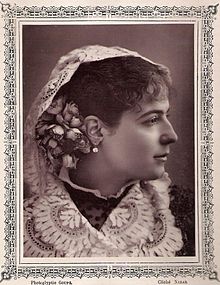Rosita Mauri

Rosita Mauri (born November 15, 1856 in Reus , † December 3, 1923 in Paris ; actually Roseta Isabel Armanda Mauri i Segura ) was a Spanish dancer and dance teacher. After her first successes in Barcelona, she appeared at leading opera houses in Europe and from 1878 appeared on stage as a prima ballerina in the Paris Opera . She inspired numerous artists of her time and was a model for well-known sculptors and painters. The state ballet school of Catalonia and the dance prize of her hometown are named in her honor.
Life
Roseta Isabel Armanda Mauri i Segura was born in Reus in 1856. Her father was a dancer himself and worked as a choreographer at the Gran Teatre del Liceu in Barcelona . He encouraged his daughter's talent for dancing at an early age and gave her first ballet lessons. At the Liceu, Roseta Mauri also received lessons from the Belgian dancer and choreographer Henri Dervine around 1862 . At the age of nine she had her first appearance in 1865 at the Teatre Principal in Palma de Mallorca . The following year she appeared on stage for the first time at the side of Vicente Moreno and Manuel Panadero at the Teatre Principal in Barcelona. The dancer, who performed as Rosita Mauri outside of her home country, made her first guest appearance abroad at the Hamburg City Theater in 1870 . Via Paris, where she briefly received further lessons from Madame Dominique, she returned to Barcelona. Here she appeared in the ballet La Hija del Aire ( The Daughter of Air ) based on a play by Pedro Calderón de la Barca and had great success with the Zarzuela Flama o La Filla del Foc . From 1871 Rosita Mauri was the prima ballerina of the Teatre Principal, and this was followed by appearances in the ballet pieces Graziela and La Torera . She then performed at La Scala in Milan in the 1872/73 season . After her return to Barcelona she took on roles in the Liceu in the plays Barba Azul ( Bluebeard ) based on the fairy tale by Charles Perrault and Editta di Belcourt by Marià Obiols i Tramullas .
In 1875, Rosita Mauri began an extensive trip to Europe, which initially took her to Berlin . At the local court opera Unter den Linden , she danced in front of Kaiser Wilhelm I and received an offer to become a permanent member of the ensemble, which she refused. Her next stop was the Teatro Comunale in Trieste , followed by the Hof Opera Theater in Vienna . After further engagements in Rome and at the Teatro Regio in Turin , she returned to Barcelona. In 1877 she was brought to Paris by the composer Charles Gounod , who had previously seen Rosita Mauri on stage in Milan, and convinced the management of the Paris Opera to hire the dancer. She made her debut at the Palais Garnier in 1878 as Venus in Gounod's Polyeucte and became prima ballerina at the Paris Opera in the same year. In the following years she inspired numerous artists. This included painters like Edgar Degas , who painted Rosita Mauri several times in her stage roles. This is not the case with Édouard Manet , whose painting, created around 1879, shows the dancer Rosita Mauri Rosita Mauri in a private setting. He had met the dancer through his school friend Antonin Proust , with whom Rosita Mauri had a long love affair. The Swedish painter Anders Zorn later portrayed both Proust and Mauri . In addition, the painters Pierre-Auguste Renoir , Ludovic-Napoléon Lepic , Léon Bonnat and Léon-François Comerre created portraits of Rosita Mauri, and she was the model for the sculptors Denys Puech , Laurent Marqueste and Eusebi Arnau .
The writer François Coppée wrote the ballet La Korrigane for her , which was premiered in 1880 with the music of Charles-Marie Widor and choreographed by Louis Mérante . Coppée followed Jules Massenet , who built a ballet piece especially for Rosita Mauri in his 1885 opera El Cid . In 1886 she appeared in the lead role of André Messager ’s Les Deux Pigeons , where she was admired by the poet Stéphane Mallarmé . She had other roles in La Farandole by Théodore Dubois , in La tempête by Ambroise Thomas and in La Maledetta by Paul Vidal . In 1894 she replaced Carlotta Zambelli as prima ballerina at the Paris Opera. Rosita Mauri ended her ballet career in 1897 in L'Etoile by André Wormser . She then worked as a dance teacher at the Paris Opera until 1920. She died in 1923 and was buried on the Cimetière Montparnasse . Since 1978 the state dance school of the Generalitat de Catalunya has been called La Escuela de danza Rosita Mauri . Her hometown Reus has hosted the Premi internacional de dansa Roseta Mauri dance competition in her honor since 2002 .
literature
- Ferran Canyameres, Josep Iglesies: La dansarina Roseta Mauri, 1850-1923 . Asociación de Estudios Reusenses, Reus 1971.
- Rosa Mauri, La bailarina más famosa de su épocha in Victor Herrero Mediavilla: Archivo Biográfico de Espana, Portugal e Iberoamérica . De Gruyter Saur, ISBN 978-3-598-34600-2 .
Web links
- Biography Rosita Mauri (French)
- Dance school La Escuela de danza Rosita Mauri in Barcelona (Catalan, Spanish, English)
- Dance competition Premi internacional de dansa Roseta Mauri in Reus (Catalan, Spanish, French, English)
| personal data | |
|---|---|
| SURNAME | Mauri, Rosita |
| ALTERNATIVE NAMES | Mauri i Segura, Roseta Isabel Armanda (full name) |
| BRIEF DESCRIPTION | Catalan dancer and dance teacher |
| DATE OF BIRTH | November 15, 1856 |
| PLACE OF BIRTH | Reus |
| DATE OF DEATH | December 3, 1923 |
| Place of death | Paris |




